Plugging Abandoned Water Wells
By: Bruce Lesikar and Justin Mechell
Texas groundwater resources critical to meeting our future needs
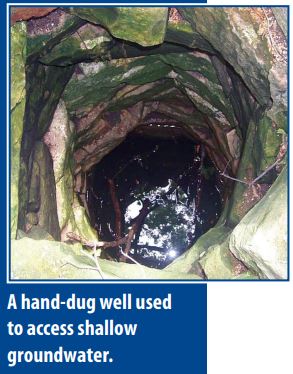
More than half of the water used in Texas is supplied by aquifers. That makes groundwater one of our most precious resources. Protecting the quality of this vital resource is the responsibility of all Texans.
Many wells around homes, farms, industrial sites and urban areas have been abandoned without being properly plugged. This creates a risk to humans, animals and our water supply that cannot be ignored.
Under Texas law, the landowner is responsible for plugging abandoned water wells and is liable for any water contamination or injury that results from an unplugged well. Before you begin the process of plugging an abandoned water well, it is highly recommended that you seek advice from your local Groundwater Conservation District (GCD), a licensed water well driller and/or pump installer in your area, or the Well Driller/Pump Installer/Abandoned Well Program of the Texas Department of Licensing and Regulation (TDLR).
Abandoned wells are threat to our water supply
An abandoned water well is a direct conduit from the surface to the aquifer below. Any contaminants on the surface can flow directly into the groundwater without natural filtration from the soil. This puts the well, and other nearby wells, at risk. If a concentrated chemical were to enter the aquifer through an abandoned well, the health of those who use water from the aquifer could be at risk. Deterioration of the well casing can also allow the co-mingling of two aquifers that are chemically different.
When is a well considered abandoned?
According to state law, a well is considered abandoned if it has not been used for 6 consecutive months. However, a well can be considered in use if its equipment is in good condition or if it has been capped. If you are uncertain whether your water well is legally abandoned, call a licensed water well driller in your area, the Well Driller/Pump Installer/Abandoned Well Program of the TDLR, or the local GCD.
How can you take care of an abandoned well?
An abandoned water well can be dealt with in three ways. The first is to return the well to an operable state by making sure the casing, pump and pump column are in good shape. The second method is to cap the well to prevent surface water or contaminants from entering it. The cap must support 400 pounds and it cannot be easily removed by hand. The third method is to plug the well from the bottom up with bentonite chips, bentonite grout or cement. Large-diameter wells can also be filled with clay-based soils, compacted clay or caliche soil.
Who can plug an abandoned well?
The three people who can legally plug an abandoned water well are the landowner, a licensed water well driller, or a pump installer.
As the landowner, you may do the work necessary to plug an abandoned water well on your property. If you plan to do it yourself, you may contact the Well Driller/Pump Installer/Abandoned Well Program of the TDLR for advice. Also request that the TDLR send you a state well plugging form.
If the well is within a GCD, notify the district of your intention to plug the well. Request the district’s plugging application and pay any applicable fees. Seek the district’s professional consultation about any other compliance issues that apply.
Within 30 days after the well is plugged, you must enter the plugging report online or send a copy of the form to the TDLR. You must also send a copy to the local GCD (if there is one).
Instead of doing the work yourself, you can hire a licensed well contractor or pump installer to plug an abandoned water well. In some cases this is recommended, because a well contractor has the proper equipment and understands the soil conditions that affect how the well should be plugged.
What are the steps in plugging an abandoned well?
Step 1. Understand the regulations that apply.
Contact the local GCD, if one exists in your area, or a licensed well contractor to learn about the local and state regulations regarding water well plugging. Learning about the rules and regulations will also help you decide if you want to plug your well yourself or hire a licensed well contractor to do the job for you.
Step 2. Obtain the water well driller’s report for the well.
Since 1965, water well drillers have been required to submit reports to the State of Texas. The water well driller’s report includes details on your well’s construction and the local geology. If you don’t already have this report, you may be able to obtain it from one of the following:
For more information, see the Texas Alliance of Groundwater Districts website or call 512-590-1422.
Step 3. Determine the well depth and the height of standing water in the well.
Measure the dimensions of the well — the diameter, depth and water level. You will need accurate measurements (not estimates) to correctly calculate the total well volume and the volume of water in the well. You will need this information to determine the amounts of materials required for disinfection and plugging.
Step 4. Remove all obstructions from the well.
It is critical that fill materials do not slump or settle; therefore, you must remove obstructions that could cause incomplete filling of the voids. Also remove all equipment and any floating debris from the well.
Step 5. Disinfect the well by adding household bleach.
All wells that contain standing water should be disinfected to kill microorganisms before plugging. Add liquid chlorine product (do not use any scented or solid products) at the rate of 1 gallon of bleach for every 500 gallons of water in the well. This is equivalent to a “shock” chlorination concentration of 100 parts per million chlorine. Chlorination ensures that disease-causing microorganisms are not sealed into the aquifer.
Step 6. Remove as much casing as possible.
This will remove the conduit for carrying contaminants to the aquifer below.
Step 7. Fill the well with plugging materials.
Plugging procedures vary depending on whether your well is:
- a large-diameter well 100 feet deep or less (see Fig. 1);
- a large-diameter well more than 100 feet deep (see Fig. 3);
- a small-diameter well with 100 feet or less of standing water (see Fig. 2); or
- a small-diameter well with more than 100 feet of standing water (see Fig. 3).
Figures 1, 2 and 3 show proper methods for plugging abandoned water wells based on the different approved methods. Figure 4 shows how the bridging of plugging material can occur if the plugging material is poured too quickly into a small-diameter well.
Step 8. Complete and submit a state well plugging form to the TDLR.
Within 30 days after the well is plugged, you must enter the plugging report online or send a completed form to TDLR at the address below. Comply with the reporting requirements of your local GCD (if present). A state well plugging form can be downloaded from the Texas Department of Licensing and Regulation website.
Texas Department of Licensing and Regulation
Well Driller/Pump Installer/Abandoned Well Program
P.O. Box 12157
Austin, Texas 78711
512-463-7880
Some areas of Texas have assistance programs for landowners who need to plug abandoned water wells.
The Texas Groundwater Protection Committee’s (TGPC) “Landowner’s Guide to Plugging Abandoned Water Wells” publication (RG-347) is an excellent resource with additional details on the plugging of abandoned water wells (e.g., the various types of plugging materials, other organizations that can provide information, and how to calculate the well depth, height of standing water in the well, and required volumes of disinfection and plugging materials).
Obtain additional information at the following websites:
- Texas Department of Licensing and Regulation
- Texas Water
- Texas Groundwater Protection Committee Abandoned Wells
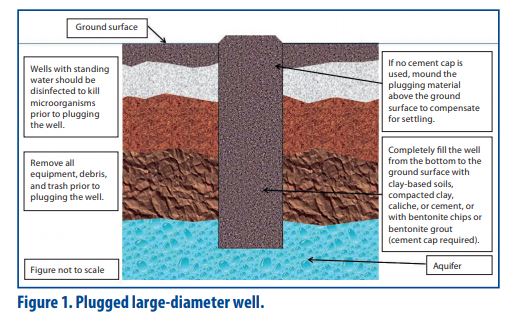
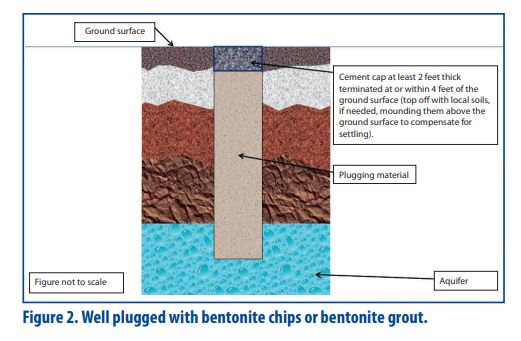
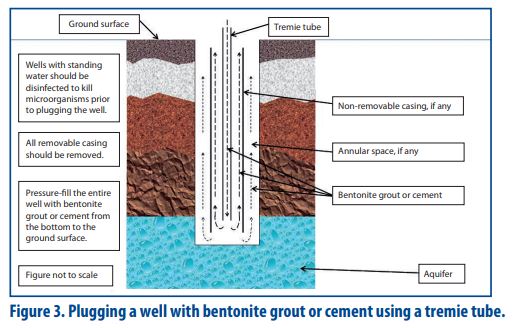
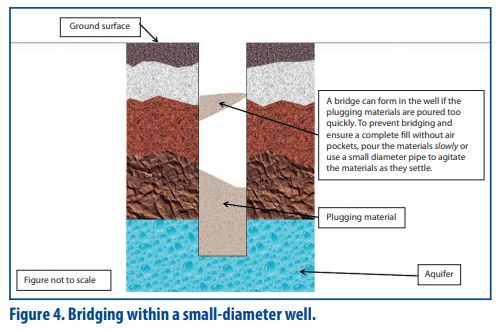
More information
For more information about water wells in Texas, visit:
- Texas Groundwater Conservation Districts
- Texas Soil and Water Conservation Districts
- Texas AgriLife Extension Service county offices
- Texas Department of Agriculture
- Texas Rural Water Association
- Texas Farm Bureau
- Texas Water Development Board
Acknowledgement
Guidance and assistance was provided by the Texas Groundwater Protection Committee and the Texas Commission on Environmental Quality.
Download a printer-friendly version of this publication: Plugging Abandoned Water Wells
